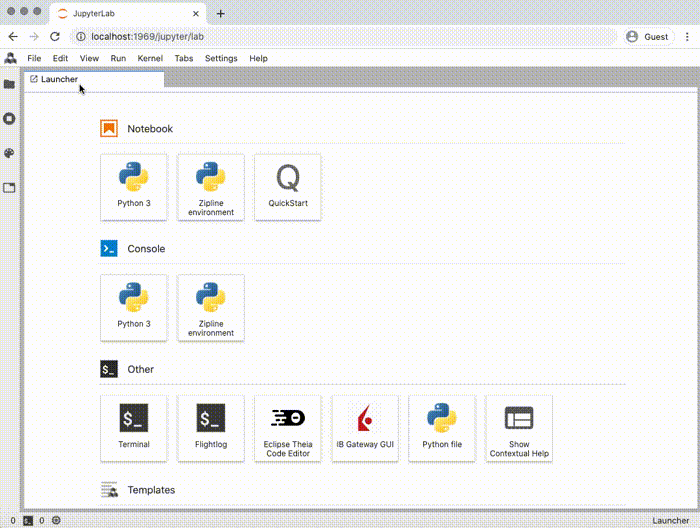Installation Tutorial for Mac
QuantRocket runs on Docker, so installing QuantRocket is a two-part process:
- install Docker
- install QuantRocket
Install Docker Desktop
Visit Docker's website and follow the instructions to download and install Docker Desktop on your computer. Make sure to choose the appropriate Docker download for the type of chip your Mac has (Intel chip or Apple Silicon chip).
After the installation, start Docker Desktop if it isn't already started.
Adjust Docker's memory setting
On MacOS, Docker runs inside a Linux VM, which is allocated a fixed portion of system memory, with the remaining memory reserved for the host operating system. By default, Docker Desktop uses 2 GB of your system memory. Giving Docker at least 8 GB of memory is recommended for QuantRocket. Generally, reserve at least 4 GB for your operating system or your computer might be sluggish. This means your computer should have a minimum of 16 GB of memory. The more memory you give Docker, the larger the backtests and data analysis you can do.
To adjust Docker's memory setting, click  ->
-> Settings in the menu bar, then click Resources -> Advanced and adjust the Memory slider to the desired position.

Install QuantRocket
To install QuantRocket, download a Docker Compose file which tells Docker how to create the QuantRocket stack. A Compose file is a YAML file that defines a multi-container Docker application.
On your Mac, open a Terminal (Applications > Utilities > Terminal).
Create a folder for QuantRocket under your home directory:
$ cd ~
$ mkdir quantrocket
$ cd quantrocketCopy and paste the following command to download the latest Compose file and save to your computer:
$ curl 'https://www.quantrocket.com/composefiles/latest/local/docker-compose.yml' -o docker-compose.yml(You can also download the Compose file from the downloads page.)
Now, use docker compose to deploy QuantRocket:
$ cd ~/quantrocket
$ docker compose -p quantrocket up -dDocker Compose will read your docker-compose.yml, pull the images down from Docker Hub, and create and run containers from the images. This process takes 5-15 minutes. You will see output like this:
⠸ flightlog Pulling
⠸ codeload [⣿] Pulling
⠸ satellite [⣿⣿⣿⣿⣿⣿⣿⣿⣿⣿⣿⣿⣿⣿⣿⣿⣿⣿⣿⣿⣿⣿⠀] Pulling
⠸ moonshot [⣿] Pulling
⠸ license-service [⣿] Pulling
⠸ account Pulling
⠸ countdown [⣿] Pulling
⠸ dash [⣿] Pulling
⠸ blotter [⣿] Pulling
⠸ ibg1 Pulling
⠸ zipline Pulling
⠸ ibgrouter Pulling
⠸ jupyter Pulling
⠸ db [⣿⣿⣿⣿] Pulling
⠸ master [⣿] Pulling
⠸ fundamental [⣿⣿⣿⣿⣿] PullingYou can list all the containers that are running:
$ docker psCONTAINER ID IMAGE COMMAND CREATED STATUS PORTS NAMES
d26da467ac03 bc77b14f9c3d "uwsgi-quantrocket -…" About an hour ago Up About an hour 80/tcp quantrocket-master-1
b1569b403b38 f2226cb5f6c3 "uwsgi-quantrocket -…" About an hour ago Up About an hour 80/tcp quantrocket-fundamental-1
fcf1c7b0fb36 1ca2dbd9bfd2 "uwsgi-quantrocket -…" About an hour ago Up About an hour 80/tcp quantrocket-realtime-1
952089561d20 fcade8902208 "uwsgi-quantrocket -…" About an hour ago Up About an hour 80/tcp quantrocket-history-1
...You can now access the Jupyter environment in your browser at:
You may want to bookmark this URL.
In JupyterLab you'll see the JupyterLab dashboard. Click the Quickstart button to find an interactive tour and other resources to help you get started with QuantRocket:

 Send a Message
Send a Message